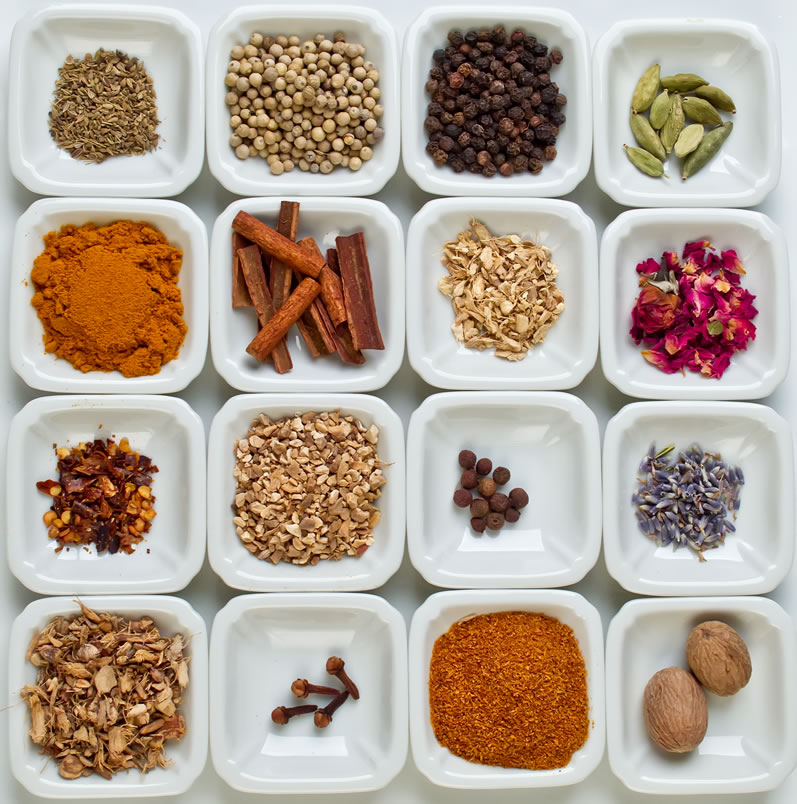 I’m in love with the flavors of Morocco: exotic spice blends, sensual floral notes, fruit and honey, briny olives, preserved lemons; fiery Harissa; moist, tender braises; charcoal grilled kebabs, silky sauces, couscous.
I’m in love with the flavors of Morocco: exotic spice blends, sensual floral notes, fruit and honey, briny olives, preserved lemons; fiery Harissa; moist, tender braises; charcoal grilled kebabs, silky sauces, couscous.
If there’s one thing that is the hook for me though, it’s the spices. My family’s roots are Mennonite and in that culinary tradition, allspice, nutmeg, and cinnamon are associated with gingerbread and oatmeal cookies, not with chicken stew. There was no dish served in my childhood home that contained cumin. I didn’t taste cardamom until I was in my teens, and rose petals and lavender as flavorings came considerably later. I may have come late to the flavors of North Africa and the Middle East, but I am making up for it now.
This past Christmas, I worked up a formula for a fragrant North African-Middle Eastern spice blend called baharat, which includes a generous dose of fragrant spices—sweet paprika, black pepper, cumin, coriander, cinnamon, cardamom, cloves, and nutmeg. But instead of using the spice blend in a savory braise, I used it in Moon over Tunisia (Baharat) Cookies. The aroma and flavor were hauntingly evocative. After that success, I began playing around with a close relative of baharat–ras el hanout–which is reputed to be the soul of Moroccan cooking.
And what is the difference between baharat and ras el hanout? I will go out on a limb and say that although ras el hanout contains many of the same spices as baharat, it should not contain cumin or paprika. Paula Wolfert, renowned author of Couscous and Other Good Food from Morocco, says it should also not contain fenugreek, coriander seeds, mustard seeds, or poppy seeds. Ras el hanout often contains 30 or more spices, however, some of them aphrodisiacs. The name means head-of-the-shop, and each spice shop owner crafts his own very special, closely guarded blend.
Nevertheless, the two blends can be quite similar, depending on the cook doing the concocting. This is especially true in commercial blends. If you plan to purchase a ready-made blend, be sure to check the ingredients on the jar. Why buy a jar of ras el hanout spice blend if it contains the same spices as the curry blend in your cupboard?
It’s infinitely better, and certainly more fun, to make your own spice blends. You can control the quality of the spices that go into the blend and create a blend that is uniquely yours. The only things you need are the spices themselves and a small coffee grinder that you use solely for grinding spices. An inexpensive Krups coffee grinder will do the trick.
Now about those spices. If you have easy access to a specialty spice store that stocks Middle Eastern, Mediterranean, and Indian spices, such as Tenzing Momo in Seattle’s Pike Place Market, you should be able to find all of the spices specified in this recipe. If not, however, you may not be able to locate dried ginger root, galangal, and orris root.
No worries on the ginger root front. You can substitute powdered ginger. Galangal and orris root are listed as optional, although they add an elusive something if you can get them. Galangal belongs to the ginger family and has a gingery, peppery, lemony bite. Orris root comes from the rhizome of the Florentine iris and lends floral, berry-like, and woodsy notes. (The easiest way to sample the flavors of these spices is to add a tablespoon of spice to a tea cup, pour boiling water over the top, wait 5 minutes, and sip.)
In my experimentation, both galangal and orris root were overshadowed by the more assertive flavors of the other spices in the blend. For floral notes, rose petals and lavender (available in tea shops) come through loud and clear. In fact, you must be careful not to overdo them. But do be alert when purchasing culinary grade rose buds or petals. If possible, smell them before purchasing. They should smell very much like fresh roses and should not have a woodsy, musky aroma.
I’ll be using ras el hanout in a few recipes in the coming months, beginning next week with Spring Chicken Tagine with Baby Artichokes, Green Olives, Preserved Lemon, and Apricots. But don’t wait until then to make this fragrant spice blend. It’s wonderful in coffee, hot or iced. Just add a teaspoon or so to dark roast coffee beans before grinding and then prepare coffee as usual.
My Ras el Hanout
I like to tweak this Moroccan spice blend. Each new batch is a little different. However, I always try to achieve a harmonious balance in which no single spice dominates. When I use ras el hanout in a dish, I often add a bit more of one or two of the spices, depending on the flavor profile I am trying to achieve. If I want a noticeable flavor and aroma of rose petal, for instance, I will add more to the dish. I might even add cumin and paprika, which are not usually included in the ras el hanout blend. The point is, ras el hanout is endlessly adaptable, and you should feel free to make it your own.
1 tablespoon black peppercorns
1 tablespoon white peppercorns
1 tablespoon ground mace
1 tablespoon ground turmeric
1 tablespoon dried rosebud petals
1 tablespoon dried ginger root (or ground ginger)
1 tablespoon galangal, optional
1 tablespoon orris root, optional
1 teaspoon dried lavender
½ teaspoon dried anise seed
½ teaspoon crushed red pepper, optional
12 allspice berries
10 green cardamom pods
2 whole nutmegs, crushed
2 cloves
1 cinnamon stick, broken
- To crush nutmegs, put into a Ziploc bag, seal, and then hit a few times with a mallet. The cinnamon stick can be broken in the same way.
- Measure all ingredients and add to a small coffee grinder used only for grinding spices.
- Pulse the grinder to begin and then let it run to grind the spices to a powder.
- Store airtight, in a cool, dark location. Use within 6 months.
Makes about ¾ cup.
More LunaCafe Spice Blends
- Baharat
- Chinese Five Spice
- Chinese Ten-Spice
- Garam Masala
- Mejadra Spice
- Ras el Hanout
- Smokin’ Hot Cajun Spice
- Warm Winter Spice
Cookin’ with Gas (inspiration from around the web)

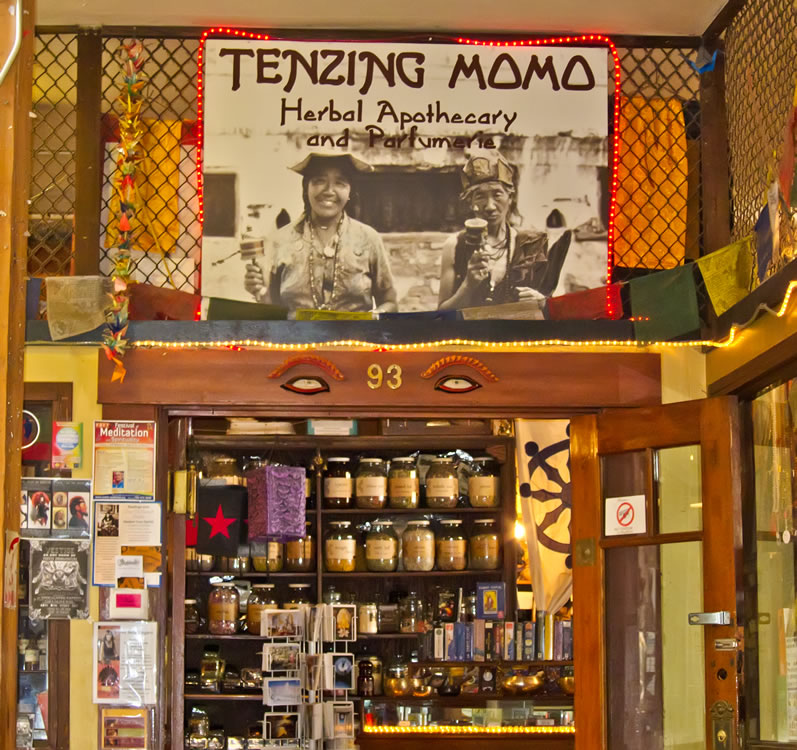
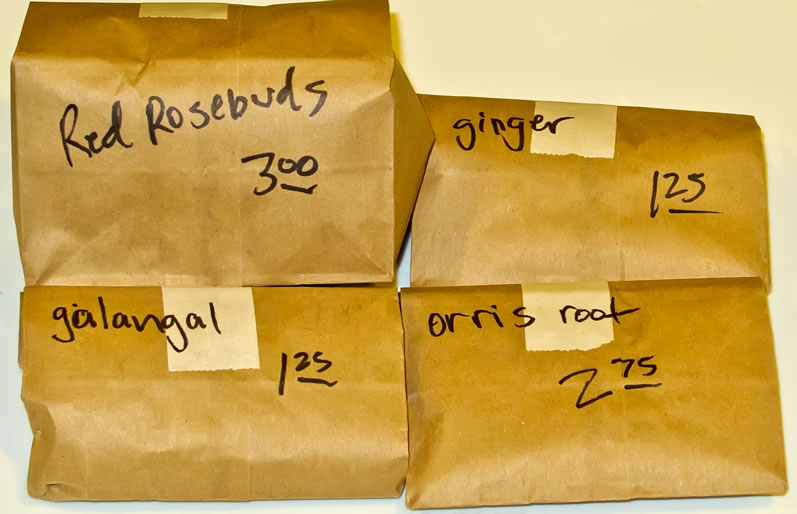
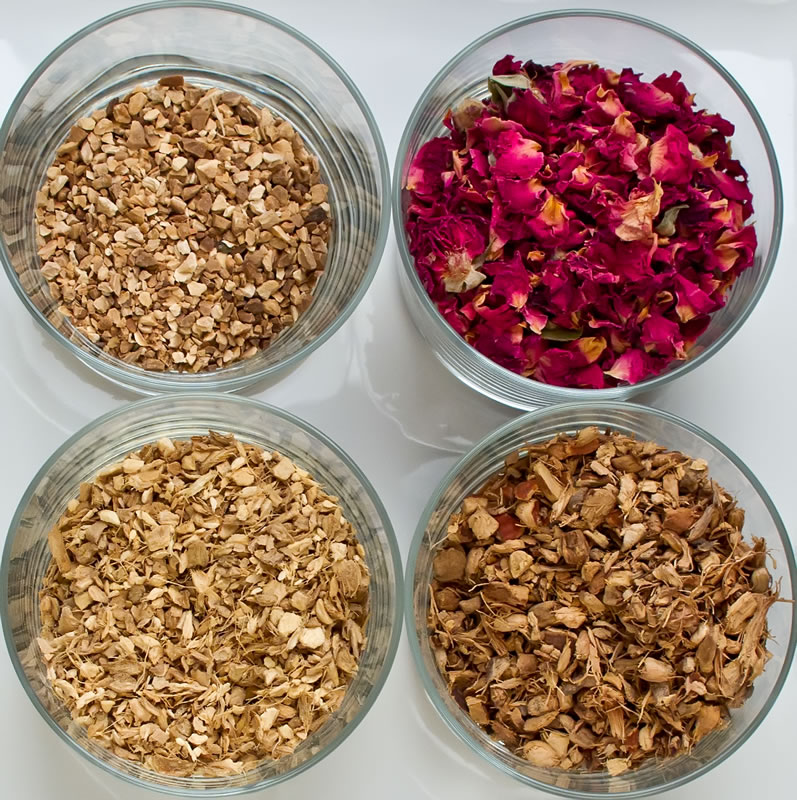
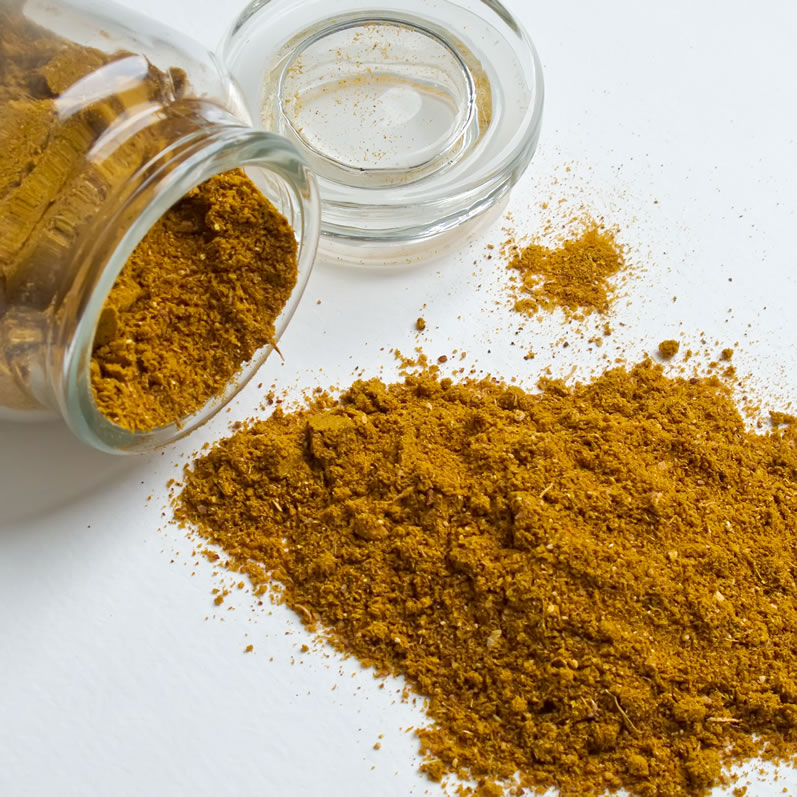
10 cardemom-pods? this must be really like soapy medicine…and to much nutmeg (along with mace)
Callie, no, not at all. Remember, this is the spice mixture, not the dish itself, and you will use only a small amount of it for any specific recipe. Thanks for stopping by…
We just had some terrific lentils flavored with Ros El Hanout blend from the World Spice Market in Seattle. Nothing but lentils, celery, onion, a spoon of vegetable base from Trader Joe’s and the spice blend.
I had an allergic reaction to Zamouri Spices version of ras el hanout, which was very sad because it was spectacular. I have had many of the spices in the blend before because I’ve cooked Indian food for many years. Some that I hadn’t had were grains of paradise, orris root, monk’s pepper, and rosebuds (though I’ve had rose water many times). I am allergic to rose pollen, though. Do you know if any of those ingredients are known to cause allergic reactions? My face broke out. It looks like your blend may be safe. I’d like to figure out what I reacted to, though, and figure out if any of these other ingredients would be safe to try. Any information or leads would be appreciated.
I’m sorry, Tapati, I don’t have any information on allergic reactions to these spices. Reactions can vary dramatically from one person to the next. The only way you can test this is to consume a tiny amount of each spice, wait for a reaction, and so on until you find the culprit. Good luck!
Thanks, Susan, I’ve been doing web searches on some of the spices in their mix and intend to track them down one by one and test them out.
This looks really fragrant and spicy! You might like to figure out how to make berberi (sp?) which is a hot mix of spices used in Ethiopian cuisine-it is used to flavor wat (stew).
Michelle, I’m on it.